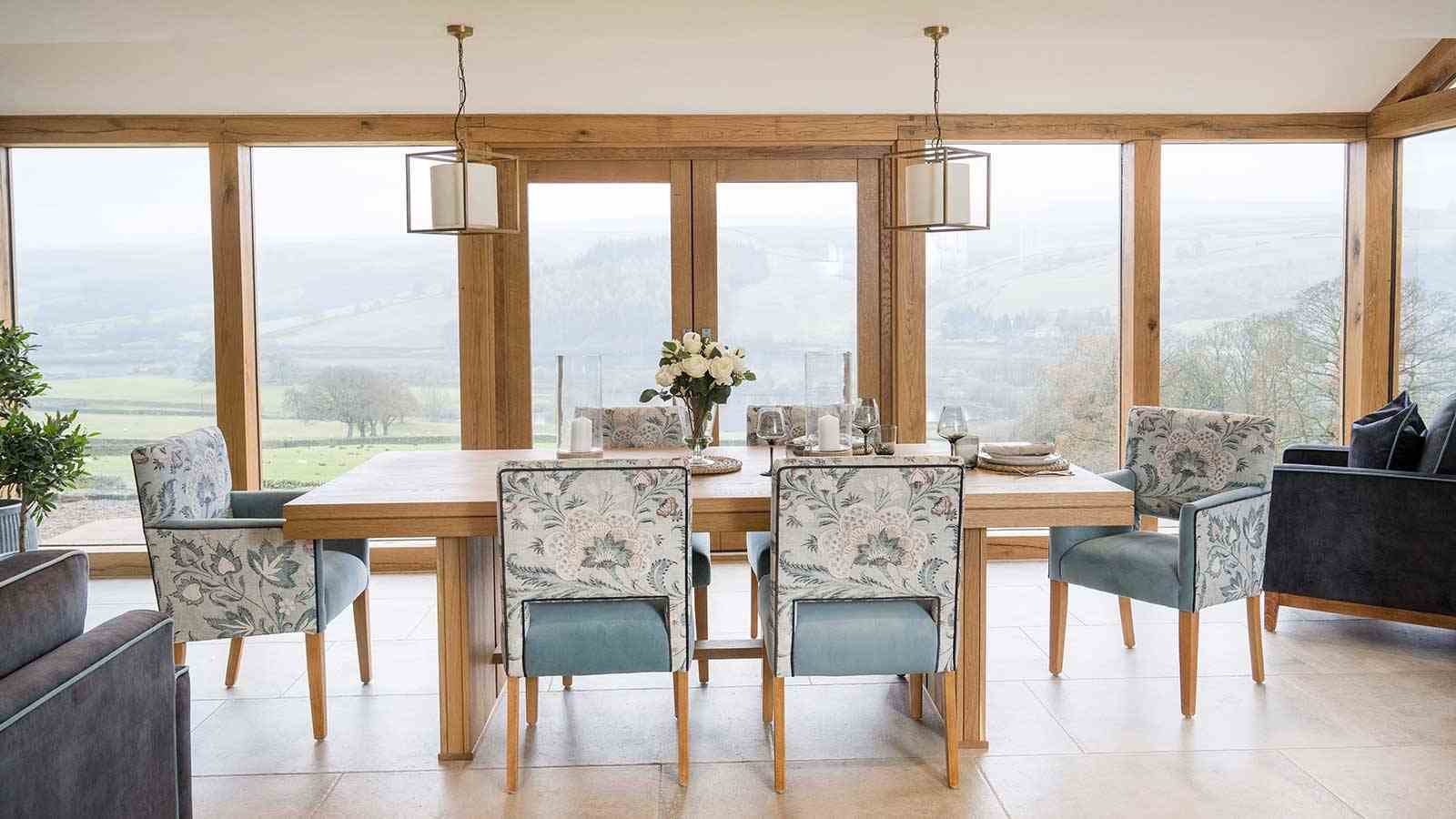
oakbydesign
01423 593 794


Early in the year, Jamie Winspear was approached by, James Eliott, director at HG2 Architects in Harrogate. He had an exciting project coming up.
James’ client was looking to breathe new life into an 18th century, rundown stone built farmhouse and barn in the Nidderdale Area of North Yorkshire, in the Yorkshire Dales.
The property has breath-taking views over the Gowthwaite Reservoir, and the Yorkshire dales beyond. The clients main brief was to ensure that the magnificent views provided the wow factor from both inside and outside the proposed family home.
Having worked with HG2 Architects on previous projects, Jamie knew that it would be a super project to get involved with. Looking at the architect’s drawings the scheme already looked to have the signs to be something special.
Oak By Design were asked to provide a full length, 6 metre, glazed oak frame extension which would occupy the full width of the kitchen/dining area of the family home.
This oak frame extension would then be fitted with a pair of oak glazed French doors. When these are opened and fixed back on to the oak frame, it feels as though the outdoors is inside, and really make the most of the views.
Oak By Design also carried out the roof works, and roof coverings, incorporating glazed windows and mono truss to the side return. The reclaimed stone used, matched in with the existing roof, linking the oak work to the existing farmhouse. All the oak was finished with 2 coats of Osmo Polyx UV Oil - 420.
The farmhouse sits up on a hillside. HG2 incorporated a stunning stone terrace to walk out from the kitchen to the outside. From there the views just get better (photos of the views to follow in the springtime).
The client and his family moved into their forever home, complete with oak frame extension, in December and enjoyed their first Christmas together. Judging by the photo, their family dog already looks settled.
The photo's (courtesy of HG2 Architects) show how the stunning kitchen and oak furniture work seamlessly with the oak structure which frames the stunning views perfectly.
Oak By Design look forward to revisiting the fabulous family home in the Spring to capture the completed landscaped gardens and views.
We hope you like this ‘case study’ as much as we do.
Oak conservatories have long been revered for their timeless appeal and classic beauty. These exquisite structures serve as a testament to the craftsmanship and elegance that defined architectural design in bygone eras.
One anachronism can be witnessed in the way these conservatories evoke a sense of nostalgia, transporting individuals to a time when life seemed simpler and more refined. The amalgamation of modern technology with traditional aesthetics creates a paradoxical experience that tugs at the heartstrings of those who appreciate the charm of yesteryears.
From an academic standpoint, oak conservatories exemplify the principles of enduring architecture. Their sturdy frames and elegant lines stand as testaments to their durability and longevity. Crafted from carefully selected oak, these structures harmoniously blend with both historic and contemporary settings, seamlessly bridging past and present.
The use of objective language allows us to examine the technical aspects of oak conservatory construction without personal bias or subjective interpretation. Traditional joinery techniques ensure precise fitting, resulting in seamless connections between components. This meticulous attention to detail not only enhances structural integrity but also adds an aesthetic element that cannot be replicated by mass-produced alternatives.
Oak conservatories embody a sense of grandeur that is unparalleled. Their expansive glass walls allow natural light to flood the interior spaces, creating an ethereal atmosphere that is conducive to relaxation and contemplation. Whether used as additional living spaces or garden sanctuaries, these structures have become iconic symbols of refined elegance throughout history.
Green oak and air-dried oak are two distinct types of timber that differ in their characteristics. Understanding these differences is crucial for anyone involved in the construction or woodworking industry.
When comparing green oak to air-dried oak, one can draw an analogy with the concept of ageing wine. Just as wine needs time to mature and develop its unique flavours, green oak requires a seasoning process to achieve optimal quality.
During the seasoning process, green oak gradually loses moisture content through natural drying methods. This reduction in moisture not only improves the stability of the wood but also prevents excessive movement and shrinkage over time. It is comparable to how ageing wine develops complexity while maintaining stability.
On the other hand, air-dried oak undergoes a different drying method. Once cut into sizeable timber pieces, it is left outside to dry naturally over an extended period. The exposure to open air allows for gradual moisture loss through evaporation, resulting in lower moisture content compared to green oak.
The metaphorical comparison between green oak and ageing wine helps illustrate how both processes require patience and time for desirable outcomes. Just as aged wine showcases its refined qualities after years of maturing, air-dried oak represents a stable and reliable material due to its prolonged seasoning period.
In summary, understanding the distinction between green oak and air-dried oak is essential when choosing timber for construction purposes. Whether opting for freshly felled or naturally dried wood, each has its advantages based on specific project requirements and desired characteristics.
Double glazing, like a masterfully constructed sandwich, offers numerous advantages to building construction. With its two panes of glass separated by a spacer bar and filled with an insulating gas, the double glazed sealed unit (DGU) acts as a formidable shield against the elements.
One key benefit of double glazing lies in its thermal insulation properties. Just as a well-insulated fortress retains its warmth while repelling cold invaders, double glazing efficiently traps heat within a room while preventing chilly drafts from infiltrating from the outside. This not only enhances comfort but also makes buildings more energy-efficient.
In addition to its exceptional thermal capabilities, double glazing provides sound insulation akin to a virtuoso performance by an acoustical maestro. By effectively reducing noise transmission through windows, it creates an oasis of calm amidst the cacophony of urban life. From bustling city streets to roaring traffic, the intrusive sounds that assail our ears are muted and transformed into mere whispers.
Furthermore, double glazing serves as an impregnable barrier against unwanted intruders. Like an impenetrable fortress wall guarding precious treasures inside, this window configuration deters potential burglars with its enhanced strength and security features. It acts as a visual deterrent while providing formidable resistance against forced entry attempts.
Moreover, double glazing exhibits remarkable durability and longevity reminiscent of ancient architectural marvels standing tall through centuries. Its robust construction withstands weathering forces such as wind and rain with grace and resilience. By resisting damage caused by external factors over time, it ensures that buildings maintain their structural integrity for years to come.
Overall, incorporating double glazing into building construction is a testament to wise foresight and meticulous attention to detail. Its multifaceted benefits encompass thermal insulation, sound reduction, enhanced security measures, and long-lasting durability—making it an indispensable component for any modern structure aspiring for excellence.
Telephone: 01423 593 794
Locksley Park
Blind Lane
Tockwith
YORK YO26 7QJ
Opening Times:
Mon to Fri - 9.00am to 5.00pm
Bank Holidays - Closed
Christmas 2025- TBC
Oak By Design is the trading name of:
Oak By Design Ltd.
Reg Number: 04384416
VAT Number: 664 8012 33